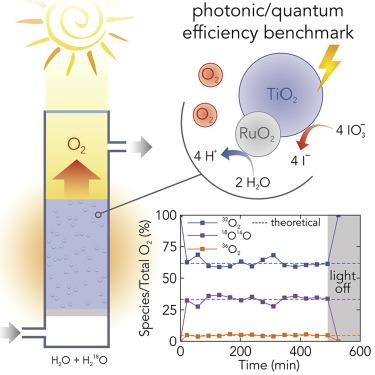Matter ( IF 17.3 ) Pub Date : 2020-08-05 , DOI: 10.1016/j.matt.2020.07.021 Hugo A Vignolo-González 1, 2 , Sourav Laha 1 , Alberto Jiménez-Solano 1 , Takayoshi Oshima 1 , Viola Duppel 1 , Peter Schützendübe 3 , Bettina V Lotsch 1, 2, 4

|
Quantitative comparison of photocatalytic performances across different photocatalysis setups is technically challenging. Here, we combine the concepts of relative and optimal photonic efficiencies to normalize activities with an internal benchmark material, RuO2 photodeposited on a P25-TiO2 photocatalyst, which was optimized for reproducibility of the oxygen evolution reaction (OER). Additionally, a general set of good practices was identified to ensure reliable quantification of photocatalytic OER, including photoreactor design, photocatalyst dispersion, and control of parasitic reactions caused by the sacrificial electron acceptor. Moreover, a method combining optical modeling and measurements was proposed to quantify the benchmark absorbed and scattered light (7.6% and 81.2%, respectively, of λ = 300–500 nm incident photons), rather than just incident light (≈AM 1.5G), to estimate its internal quantum efficiency (16%). We advocate the adoption of the instrumental and theoretical framework provided here to facilitate material standardization and comparison in the field of artificial photosynthesis.
中文翻译:

以RuO2 @ TiO2为基准,实现标准化的光催化氧气释放速率。
在不同的光催化装置之间进行光催化性能的定量比较在技术上具有挑战性。在这里,我们将相对和最佳光子效率的概念结合在一起,以使用内部基准材料(在P25-TiO 2上光沉积的RuO 2)来规范化活动光催化剂,针对氧气析出反应(OER)的可重复性进行了优化。此外,还确定了一套通用的良好做法,以确保对光催化OER进行可靠的定量,包括光反应器设计,光催化剂分散和控制由牺牲电子受体引起的寄生反应。此外,提出了一种结合光学建模和测量的方法来量化基准吸收光和散射光(分别为λ的7.6%和81.2% = 300–500 nm的入射光子),而不只是入射光(≈AM1.5G),以估计其内部量子效率(16%)。我们提倡采用此处提供的工具和理论框架,以促进人工光合作用领域中的材料标准化和比较。











































 京公网安备 11010802027423号
京公网安备 11010802027423号